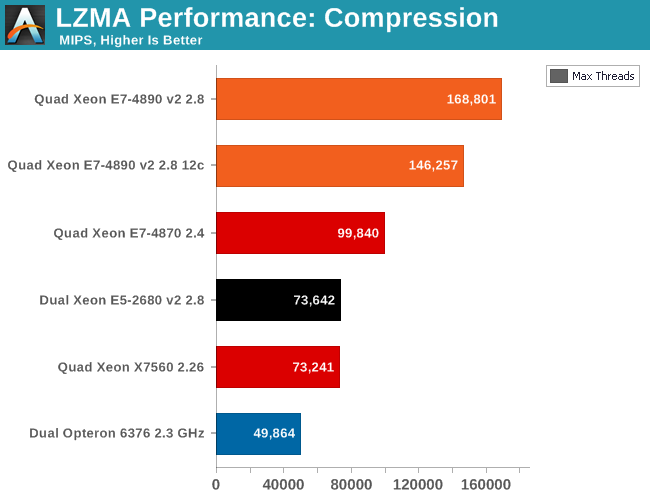The Intel Xeon E7 v2 Review: Quad Socket, Up to 60 Cores/120 Threads
by Johan De Gelas on February 21, 2014 6:00 AM EST- Posted in
- IT Computing
- Intel
- Xeon
- Ivy Bridge EX
- server
- Brickland
Multi-Threaded Integer Performance
How do the new Xeon E7 v2 chips compare to the existing Xeon servers when it comes to some multi-threaded workloads?

When it comes to raw integer processing, the new Xeon delivers up 70% better performance than the previous generation and up to 2.3x better performance than the Xeon X7560. With only 12 cores active to simulate performance of the 12-core models, e.g. E7-8857 v2 and E7-4860 v2, we can get a rough idea how the interesting 3GHz 12-core E7-8857 v2 performs, which has the same TDP (130W) as the previous generation. In those circumstances the new Xeon E7 v2 is 50% faster than the previous generation and twice as fast as the Xeon 7560 (and the actual E7-8857 v2 will be clocked slightly higher).

Decompression gives a similar performance landscape, though the E5-2680 now drops below the X7560.










125 Comments
View All Comments
snoopy1710 - Friday, February 21, 2014 - link
Minor correction on the Dell E7-4890 SAP benchmark, which was done on SUSE Linux Enterprise Server for SAP Applications:http://download.sap.com/download.epd?context=40E2D...
Snoopy
FunBunny2 - Friday, February 21, 2014 - link
you should opt for ubuntu 12.04. "real" databases are approved only for LTS versions, and 12.04 is the latest.bji - Friday, February 21, 2014 - link
Page 10 does not contain the Linux Kernel Compile time benchmarks.JohanAnandtech - Saturday, February 22, 2014 - link
The web engine did something weird...I restored the pageJawsOfLife - Friday, February 21, 2014 - link
Very thorough review, which is what I've come to expect from Anandtech! I am interested but not very knowledgeable about the server side of computing, so this definitely filled me in on a lot of the facets of that area. Thanks for the writeup.By the way, the "Linux Kernel Compile" page is blank, as bji noted.
JohanAnandtech - Saturday, February 22, 2014 - link
Thx. A glitch in the engine made it delete a page. Restored.iwod - Friday, February 21, 2014 - link
While the revenue are high, just how many unit are shipped?I have been thinking if Intel would move Mobile First, meaning Atom, Tablet and Laptop Chips all gets the latest node first, which are low power design. While Desktop and Server will be a Architecture and Node behind. Which will align the Desktop and Xeon E3 - E5 Series.
But it seems the volume of Chips dont quite measure out, since the top end volume are far too small? Anyone have any idea on this.
dealcorn - Saturday, February 22, 2014 - link
I believe the statement "Still, that tiny amount of RISC servers represents about 50% of the server market revenues." should read "Still, that tiny amount of RISC servers represents about 50% of the high end server market revenues." Stated differently, from a revenue perspective Intel is #1 vendor in the high end segment even though it has less than a 50% market share. Server orders are placed with vendors, not architectures. Intel has fought an uphill battle to access the high end market and it is costly. However, if Intel can amortize its development costs over a larger revenue base than any competitor, it is well positioned to maintain it's share acquisition momentum.NikosD - Saturday, February 22, 2014 - link
@JohanVery nice review, I would like to see more benchmarks between E7 v2 vs RISC processors because I think the real competition is there.
Older Intel and AMD servers are not real competition for IvyBridge-EX.
It would be interesting when POWER8 is out, to give us the new figures of 8 socket benchmarks and if there is any progress on more 8+ sockets for Intel E7 v2 (built by Cray and other vendors)
I think that E7 v2 (I don't know about older vendors) can be placed in up to 32-socket systems - not natively of course.
JohanAnandtech - Saturday, February 22, 2014 - link
Older Intel systems are competition, because these kind of servers are not replaced quickly. If a new generation does not deliver substantial gains, some companies will postpone replacement. In fact, very few people that already have a quad intel consider the move to RISC platforms.But you have a point. But it is almost impossible for us to do an independent review of other vendors. I have never seen an independent review, and the systems are too scarce, so there is little chance that we can ask a friendly company to borrow us one.